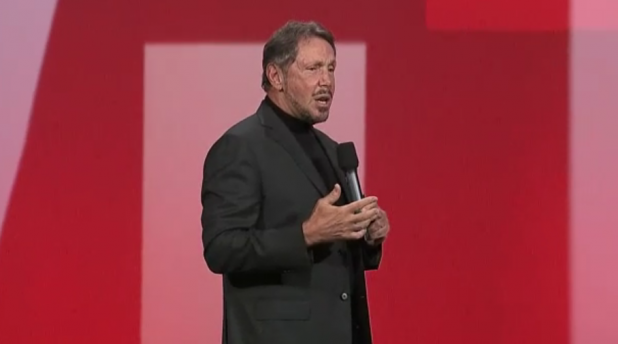[caption id="attachment_4857" align="aligncenter" width="618"]  Oracle CEO Larry Ellison used his OOW keynote to make four major announcements.[/caption] Oracle CEO Larry Ellison used his opening keynote at Oracle Open World (OOW) to unveil several initiatives to accelerate the cloud, including its own private cloud, Infrastructure-as-a-Service, and its latest database version—which, coincidentally, can be stored in memory within Oracle’s latest Exadata database machines. Ellison also paid tribute to Oracle hardware partner Fujitsu, which had earlier announced “Project Athena”: a server designed with a UltraSPARC chip that (he claimed) can run the Oracle database “faster than any microprocessor on the planet.” Ellison opened OpenWorld with four key announcements: that Oracle is now offering infrastructure as a service; that it will complement the IaaS offering by allowing customers to run that same infrastructure behind their corporate firewall as a private cloud; the launch of Oracle database 12C (where the “c” stands for “cloud”); and, finally, the new Exadata servers, which barely use disk drives at all in-favor of in-memory storage, with flash memory as a fallback. Ellison termed the concept of the cloud a very old one, dating back one hundred years or so as with the first utilities. That notion of services, he added, helped drive Oracle’s own embrace of Software-as-a-Service (SaaS), Platform-as-a-Service (PaaS) and finally Infrastructure-as-a-Service (IaaS). “What we’re offering is our OS, our VM, our compute services and storage services on the fastest most reliable systems in the world—our engineered systems, Exadata, Exalogic, Exalytics—all linked with Infiniband,” Ellison said. “We’re adding a new line of business, cloud computing, to our traditional lines of business: selling software and selling hardware.” A number of customers are excited about using infrastructure as a service in Oracle’s data center, he continued. But for those that don’t, there’s a private cloud option that places the same exact hardware behind the customer’s firewall: “You could put that service in our data center and run the identical one on our floor or your floor. “We own it, we manage it, we upgrade it—you pay a monthly fee for what you use,” Ellison said. Oracle will work with customers to estimate the amount of usage that customers will use, so that they will be able to accommodate their costs. The Oracle private cloud will run “all” Oracle software, including the expected Fusion applications, along with Oracle’s customized software services such as Siebel and PeopleSoft. Customers can develop new applications on the private cloud and tap into Oracle database and Fusion middleware, which also runs on the Oracle private cloud.
Oracle CEO Larry Ellison used his OOW keynote to make four major announcements.[/caption] Oracle CEO Larry Ellison used his opening keynote at Oracle Open World (OOW) to unveil several initiatives to accelerate the cloud, including its own private cloud, Infrastructure-as-a-Service, and its latest database version—which, coincidentally, can be stored in memory within Oracle’s latest Exadata database machines. Ellison also paid tribute to Oracle hardware partner Fujitsu, which had earlier announced “Project Athena”: a server designed with a UltraSPARC chip that (he claimed) can run the Oracle database “faster than any microprocessor on the planet.” Ellison opened OpenWorld with four key announcements: that Oracle is now offering infrastructure as a service; that it will complement the IaaS offering by allowing customers to run that same infrastructure behind their corporate firewall as a private cloud; the launch of Oracle database 12C (where the “c” stands for “cloud”); and, finally, the new Exadata servers, which barely use disk drives at all in-favor of in-memory storage, with flash memory as a fallback. Ellison termed the concept of the cloud a very old one, dating back one hundred years or so as with the first utilities. That notion of services, he added, helped drive Oracle’s own embrace of Software-as-a-Service (SaaS), Platform-as-a-Service (PaaS) and finally Infrastructure-as-a-Service (IaaS). “What we’re offering is our OS, our VM, our compute services and storage services on the fastest most reliable systems in the world—our engineered systems, Exadata, Exalogic, Exalytics—all linked with Infiniband,” Ellison said. “We’re adding a new line of business, cloud computing, to our traditional lines of business: selling software and selling hardware.” A number of customers are excited about using infrastructure as a service in Oracle’s data center, he continued. But for those that don’t, there’s a private cloud option that places the same exact hardware behind the customer’s firewall: “You could put that service in our data center and run the identical one on our floor or your floor. “We own it, we manage it, we upgrade it—you pay a monthly fee for what you use,” Ellison said. Oracle will work with customers to estimate the amount of usage that customers will use, so that they will be able to accommodate their costs. The Oracle private cloud will run “all” Oracle software, including the expected Fusion applications, along with Oracle’s customized software services such as Siebel and PeopleSoft. Customers can develop new applications on the private cloud and tap into Oracle database and Fusion middleware, which also runs on the Oracle private cloud.
 Oracle CEO Larry Ellison used his OOW keynote to make four major announcements.[/caption] Oracle CEO Larry Ellison used his opening keynote at Oracle Open World (OOW) to unveil several initiatives to accelerate the cloud, including its own private cloud, Infrastructure-as-a-Service, and its latest database version—which, coincidentally, can be stored in memory within Oracle’s latest Exadata database machines. Ellison also paid tribute to Oracle hardware partner Fujitsu, which had earlier announced “Project Athena”: a server designed with a UltraSPARC chip that (he claimed) can run the Oracle database “faster than any microprocessor on the planet.” Ellison opened OpenWorld with four key announcements: that Oracle is now offering infrastructure as a service; that it will complement the IaaS offering by allowing customers to run that same infrastructure behind their corporate firewall as a private cloud; the launch of Oracle database 12C (where the “c” stands for “cloud”); and, finally, the new Exadata servers, which barely use disk drives at all in-favor of in-memory storage, with flash memory as a fallback. Ellison termed the concept of the cloud a very old one, dating back one hundred years or so as with the first utilities. That notion of services, he added, helped drive Oracle’s own embrace of Software-as-a-Service (SaaS), Platform-as-a-Service (PaaS) and finally Infrastructure-as-a-Service (IaaS). “What we’re offering is our OS, our VM, our compute services and storage services on the fastest most reliable systems in the world—our engineered systems, Exadata, Exalogic, Exalytics—all linked with Infiniband,” Ellison said. “We’re adding a new line of business, cloud computing, to our traditional lines of business: selling software and selling hardware.” A number of customers are excited about using infrastructure as a service in Oracle’s data center, he continued. But for those that don’t, there’s a private cloud option that places the same exact hardware behind the customer’s firewall: “You could put that service in our data center and run the identical one on our floor or your floor. “We own it, we manage it, we upgrade it—you pay a monthly fee for what you use,” Ellison said. Oracle will work with customers to estimate the amount of usage that customers will use, so that they will be able to accommodate their costs. The Oracle private cloud will run “all” Oracle software, including the expected Fusion applications, along with Oracle’s customized software services such as Siebel and PeopleSoft. Customers can develop new applications on the private cloud and tap into Oracle database and Fusion middleware, which also runs on the Oracle private cloud.
Oracle CEO Larry Ellison used his OOW keynote to make four major announcements.[/caption] Oracle CEO Larry Ellison used his opening keynote at Oracle Open World (OOW) to unveil several initiatives to accelerate the cloud, including its own private cloud, Infrastructure-as-a-Service, and its latest database version—which, coincidentally, can be stored in memory within Oracle’s latest Exadata database machines. Ellison also paid tribute to Oracle hardware partner Fujitsu, which had earlier announced “Project Athena”: a server designed with a UltraSPARC chip that (he claimed) can run the Oracle database “faster than any microprocessor on the planet.” Ellison opened OpenWorld with four key announcements: that Oracle is now offering infrastructure as a service; that it will complement the IaaS offering by allowing customers to run that same infrastructure behind their corporate firewall as a private cloud; the launch of Oracle database 12C (where the “c” stands for “cloud”); and, finally, the new Exadata servers, which barely use disk drives at all in-favor of in-memory storage, with flash memory as a fallback. Ellison termed the concept of the cloud a very old one, dating back one hundred years or so as with the first utilities. That notion of services, he added, helped drive Oracle’s own embrace of Software-as-a-Service (SaaS), Platform-as-a-Service (PaaS) and finally Infrastructure-as-a-Service (IaaS). “What we’re offering is our OS, our VM, our compute services and storage services on the fastest most reliable systems in the world—our engineered systems, Exadata, Exalogic, Exalytics—all linked with Infiniband,” Ellison said. “We’re adding a new line of business, cloud computing, to our traditional lines of business: selling software and selling hardware.” A number of customers are excited about using infrastructure as a service in Oracle’s data center, he continued. But for those that don’t, there’s a private cloud option that places the same exact hardware behind the customer’s firewall: “You could put that service in our data center and run the identical one on our floor or your floor. “We own it, we manage it, we upgrade it—you pay a monthly fee for what you use,” Ellison said. Oracle will work with customers to estimate the amount of usage that customers will use, so that they will be able to accommodate their costs. The Oracle private cloud will run “all” Oracle software, including the expected Fusion applications, along with Oracle’s customized software services such as Siebel and PeopleSoft. Customers can develop new applications on the private cloud and tap into Oracle database and Fusion middleware, which also runs on the Oracle private cloud.
